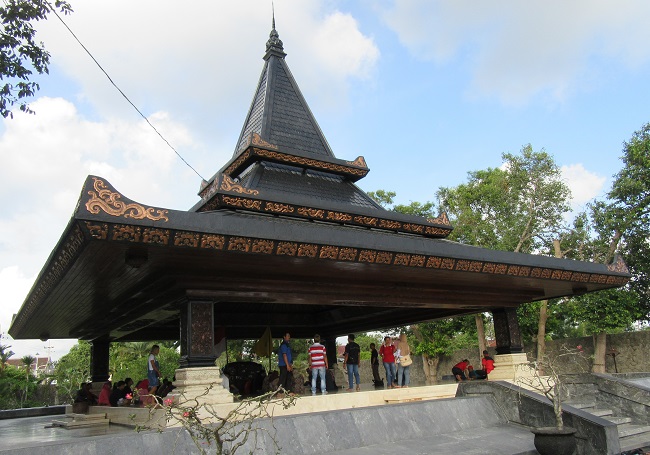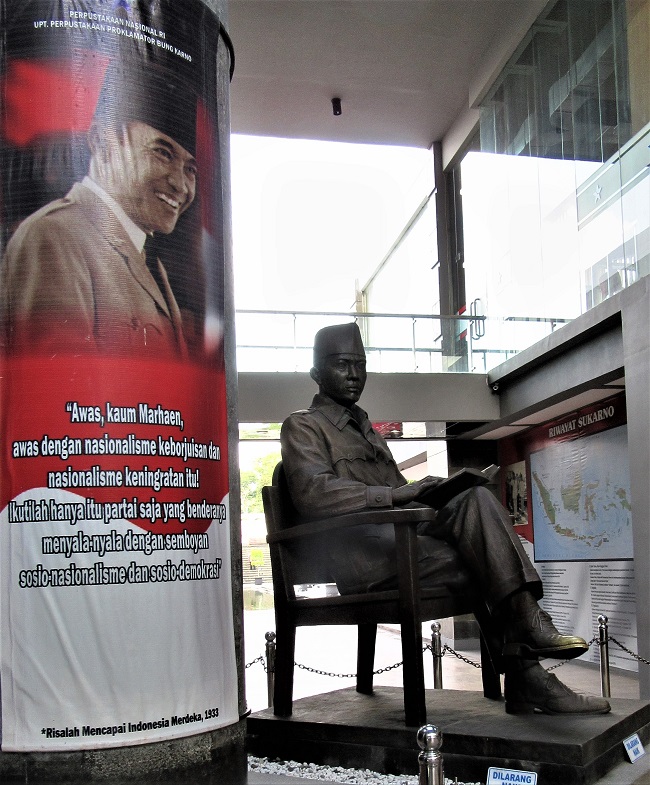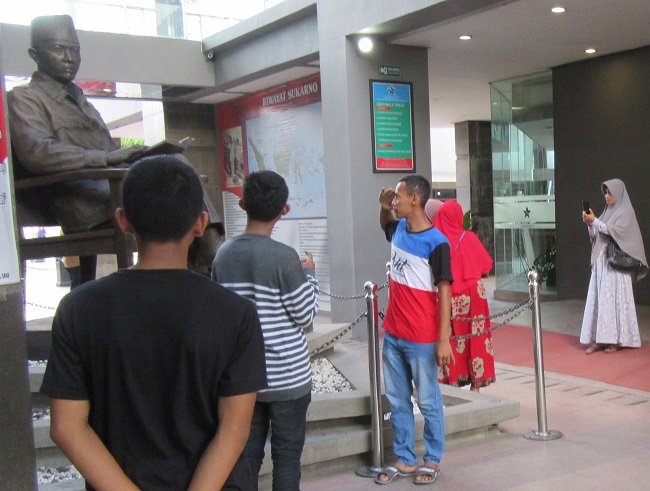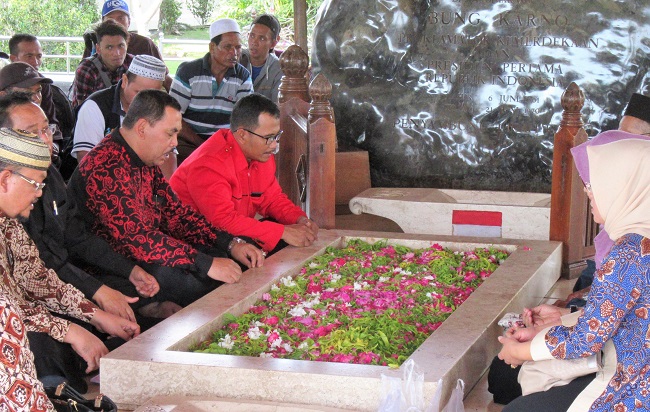Sukarno’s gravesite is very popular but there is much irony in the way his memory is celebrated
Ian Chalmers
Deep in the mountains above Blitar, a small and pretty city in East Java, lies the final resting place of Sukarno, the first president of Indonesia who declared his nation’s independence on 17 August 1945.
Standing beside Sukarno on this day was the skilled economist and devoutly Muslim Mohammad Hatta, who thus became the second ‘Proklamator’ of independence. But unlike Hatta, who was a Sumatran, Sukarno’s secular nationalism drew deeply on Javanese traditions of populism. Today, Sukarno is remembered as the flamboyant leader who was able to unite disparate social forces behind the struggle for national liberation.
For two decades after this declaration Sukarno dominated political life through populist appeals, mobilising mass support behind his charismatic leadership. And his popularity persists. A recent visit to the gravesite shows that, more then seventy years after the 1945 declaration, thousands of people from remarkably diverse social groups regularly visit the grave to show that they still support his somewhat bombastic nationalism.
Sukarno had asked to be buried in a simple grave close to the national palace in Bogor where he had been placed under house arrest following the prolonged coup of 1965-66, a bloody series of military actions coordinated by the then general Suharto. As the regime embarked on a campaign to eliminate communists and their alleged sympathisers, years of massive social and political turmoil followed. But despite this brutal assault on civil society, the military-led regime did not yet have firm grip on power. By 1967 Suharto had gradually eased the first president out of office and away from ideological influence.
Even after Sukarno’s death in 1970, the new president feared that a revival of Sukarnoist nationalism would challenge his hold on power; and that the gravesite might ferment opposition. So Suharto had him buried in far-off Blitar, the town where Sukarno had lived with his grandparents when he was a child.
As Suharto’s hold on power consolidated, he gradually grew more confident that he could contain – and perhaps draw on – Sukarno’s legacy. In 1978 construction began of an extensive and expensive mausoleum over the grave in the form of an East Javanese pavilion (joglo). However, this effort backfired. While indicating that this ‘New Order’ respected Sukarno’s historical role as a hero of the revolution, it soon became clear that Sukarno’s legacy had its own dynamic, one that could not be controlled by the new regime. Today, the way in which his memory is celebrated in Blitar presents us with a number of delicious ironies.

A site of opposition
The first and most obvious irony is that, far from providing Suharto with political legitimacy, the site almost immediately became a venue for people to safely demonstrate their opposition to the then new political system. After Sukarno was buried his followers would come to the grave each year to commemorate the anniversary of his death. A tradition emerged whereby thousands would descend on Blitar each 21 June, grimly reminding Suharto of what many people felt they had lost. A strong police presence was maintained to prevent over-enthusiastic expressions of support for populist Sukarnoism. But this did not reduce the vigour of his supporters. When the mausoleum was completed in 1979 tens of thousands (and perhaps hundreds of thousands) turned out to witness its dedication. As Suharto’s former minister of mines Slamet Bratanata reflected at the time, ‘young people don't see Suharto as a leader… They see a dead man as better than the living.’
This association with Sukarno has powerful cultural roots, and persists to this day. Even in the 1980s and 1990s, when the New Order regime was at the height of its power, many Javanese looked back to Sukarno as a ‘ratu adil’, the legendary just king who would have ushered in a glorious future if he had not been overthrown. The site thus became a venue for critics to express implicit opposition to the regime in the lead-up to the four five-yearly elections that were held in the 1980s and 1990s. In particular, it became something of a holy shrine for the PDI (Indonesian Democracy Party), the political party led by Sukarno’s daughter Megawati Soekarnoputeri (later renamed PDIP, Indonesian Democratic Party of Struggle).
In the post-Suharto era both aspiring and serving politicians still come to the grave to pay their respects. Before he was elected president in 2014 Joko Widodo (Jokowi) visited the grave to seek Sukarno’s blessing – and thus gain the support of his followers. And today, before announcing that they will run for office, politicians religiously come to Blitar to pledge their loyalty to Sukarno’s legacy, indicating that the grave remains a source of legitimacy beyond the power of government.
The second irony relates to the religious significance often given to the mausoleum, for the grave itself has become a place of pilgrimage for many Muslims. Within Islam, the veneration of gravesites is controversial. Many Muslims consider it blasphemous (syirik) to pray to someone who is now deceased. Yet there is a deep tradition in Java of visiting the graves of holy men on the anniversary of their death. Followers thus often come to pray at the graves of the Wali Songo, the nine saints said to have brought Islam to Java and whose graves are scattered around the island.
Similarly, tens of thousands of devout Javanese visit Sukarno’s grave every year, hoping to gain his spiritual blessing (berkat). It has now became a major site for what is called grave-visiting tourism (wisata ziarah). Indeed, when visiting the site in late 2018 I witnessed a group of men and women crouched around the grave, chanting as they rocked backwards and forwards. They were humbly requesting a favour, while repeating the first and most important of the Five Pillars of Islam, the affirmation in Arabic that ‘I give witness that there is no God but God’.
The reverence displayed by devout believers today is doubly ironic for, after he came to power, Sukarno was a very pragmatic politician whose motives were not particularly religious. He did make use of Islamic symbols when it served his political agenda, such as prior to 1945 when he marshalled the diverse groups struggling for independence. But after he became president and eventually instituted Guided Democracy, naming himself Great Leader of the Revolution, he maintained his power base through populist appeals to charismatic leadership, while drawing on coalitions of primarily secular political forces – nationalist, socialist, and communist. By contrast, devout Muslim politicians became some of his most fierce critics.

Preserving a national asset
The third and final irony is to be found in how Sukarno’s legacy has been institutionalised. In recent decades various governments have attempted to formalise his influence. In 2003, partly in order to cope with the growing number of visitors, the mausoleum was considerably expanded and modernised in a joint effort between the national, provincial and district governments. And in 2004, by the initiative of the Blitar district government, the massive Bung (‘Comrade’) Karno Library and Museum was opened by the then president Megawati. As the official website declares, the purpose of these two buildings is to preserve ‘the concepts, ideas and intellectual legacy of Bung Karno as a national asset’.
When we delve into this political ideology, however, we find that its content is quite thin. The noted scholar of Indonesian cultural history, Ben Anderson, once warned against the danger of the ‘fossilisation’ of Sukarno’s thought, whereby his ideas for building the Indonesian nation were celebrated without reference to their shortcomings – or the need to adapt to changing contexts. Yet this seems to have been precisely what has occurred in Blitar. The mausoleum lies next to a modern building containing a large metal statue of the first president, which has become a place of special significance for many young people seeking to revere the past. Scattered around this statue are excerpts and slogans from his most famous speeches, emphasising the need for the people to unite against foreign enemies while exhorting the nation to build the world anew. However, the populist appeals that run throughout Sukarno’s numerous writings and speeches are becoming less and less relevant as Indonesia is increasingly required to interact with other nations and international organisations to obtain the political and economic resources it requires. For many observers, the veneration of Sukarno is little more than a sentimental longing for a glorious past.

Nevertheless, it is perhaps the very vagueness of such appeals that accounts for their popularity. Sukarno’s populism continues to attract support from a diverse range of groups that seek a historical basis for their social and political agendas: devout Muslims, secular nationalists, ethnic and religious minorities, pro-democracy activists, youthful patriots, leftist socialists, sports clubs, martial arts groups and right-wing critics of contemporary political trends – as well as serving and aspiring politicians. In other words, as is the case for all forms of populist ideology, Sukarno’s populist nationalism is enormously powerful as an ideology, but provides no formula for political change.
Ian Chalmers (Ian.Chalmers@uwa.edu.au) is a senior lecturer and reseacher in the School of Social Sciences, University of Western Australia.
